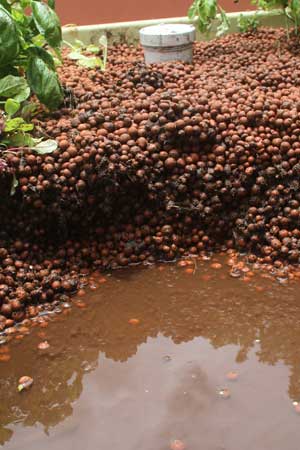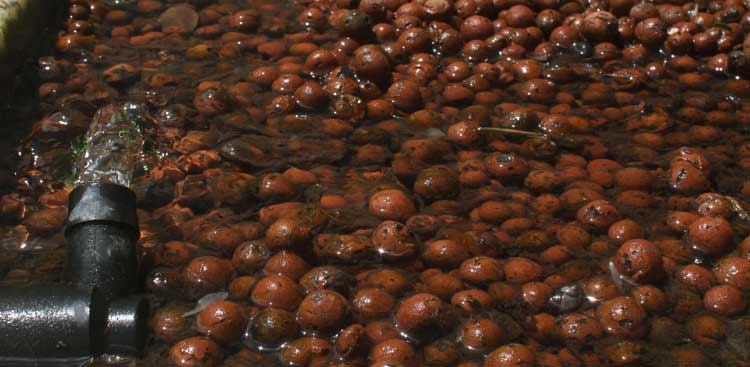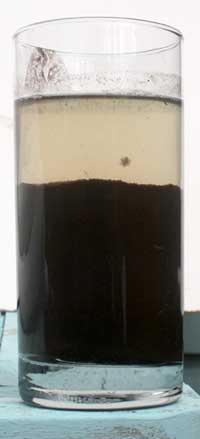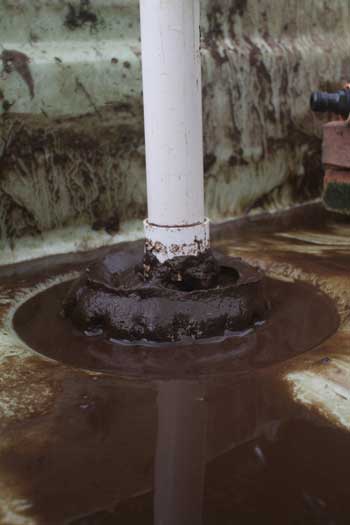Cleaning a 3 Year old Grow Bed
Its a messy time consuming job but eventually you got to do it. Cleaning out a Grow-bed full of fish crap after three years of service.
Following on from a previous post we wrote about how long can old media growbeds last using using three quarter inch gravel? The answer seems to be around 5 years.
But what about hydroton? How long will it last?
Hydroton or Lecca are those little round clay pebbles that are often used in the hydroponics world. The conventional wisdom was generally thought around 18 months.
Last week we got our answer in our own aquaponics system. Its been running continually non stop now for around three years with little maintenance. The only tidy up it received was a bamboo stick into the autosiphon to pick out a few plant roots strangling the siphon and a rusty horse shoe that was found buried in the other end! A good luck charm? Who knows.
The tell tale sign we were experiencing was the pooling of water on the surface of the media. Sometimes this can be attributed to the water flowing too fast into the grow-bed, but not on this occasion. The water was flooding the surface of the bed and refusing to soak into the media.
We dug around the spreading patch of surface water, looking for any obstruction like decaying old plant root balls but none could be found.
The water was not soaking into the hydroton. There was no fish smells or any foul odour at all.
The system started to resemble a rice paddy field with a perpetual flooded top surface area.
Why was this?
Fish Waste
The answer became more apparent when you take a closer look at the fish solids that are being pumped continually into your grow-beds from the fish tank.
Fish solids separate from water quite readily.
Digging into the media revealed that the system after three years with no maintenance at all has pretty well collected the entire output of fish waste and deposited this fertility throughout the entire grow-bed.
Taking a sample of the chocolate brown coloured fish waste shows that within minutes of settling into a glass container, the fish solids quickly sink to the lower layer forming a heavy barrier, that with time, will impede the flow of water on its way to the auto-siphon and back to the fish tank.
Shorter Siphon Cycles spell trouble
Even with three years of no service, the grow-beds still functioned as normal and managed to filter the water just like a traditional wetland.
But we began to notice a problem with the auto-siphons.
They began to fill faster than the normal 14 minute lag that it took for the growbeds to flood and drain at the start, three years ago.
They were filling and dumping water a lot faster. Within 3 minutes in fact.
Shorter cycles suggested the grow-beds had obstructions and were not dumping most of the water.
Cleaning the System
Digging deep showed the system was pretty well full of fish crap.
Plants were still growing but the system needed a good clean out. The good bit about cleaning hydroton is that it separates from the fish crap quite easily.
Devising an old wire waste paper bin and shaking the basket full of old hydroton in a larger bucket full of water easily removed the crap from the balls.
An automated cement mixer might have been easier to implement if one was available – but this simple system proved to be quite effect, but labor intensive.
Its a messy all day job.
Nearly every handful of dirty clay balls showed one or two wriggling compost worms. There were heaps of them in the system.
When all the pebbles were removed, it was time to inspect the siphon upstand.
When the outer shroud was lifted we noticed an inch and a half of undisturbed fish crap sitting like a fat spreading donut at the base of the upstand.
This is the heaviest of the fish waste. No off smells or dead-zones. No anaerobic conditions.
Just a nice dense layer of the stuff which would have covered the entire bottom inch or two of the grow-bed if left undisturbed.
Recycling the Fish Waste
The fish waste was eventually all recycled onto other vegetable gardens and even the lawn got a good dose of the stuff.
Returning the washed hydroton was a lot faster than removing it. Turning the water back on and replanting with fresh seedlings and the system was back to normal pumping out vegetables.
Will we get another three years service out of this bed? Possibly. There is still enough bacteria and worms adhering to all the pebbles so there will be no shock to the system at all. The worm numbers will rebuild in time and the cycle continue for another few years.
Over the three year period this grow-bed produced a lot of food. Spending one day cleaning it isn’t so bad after all.










God only knows how hard this would be with heavy gravel
I thought snails would be a practical application for fish waste..